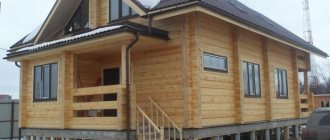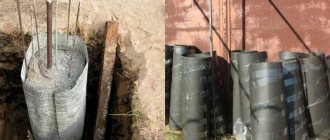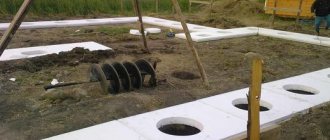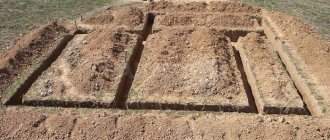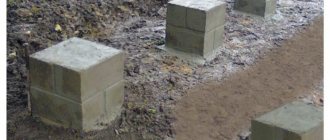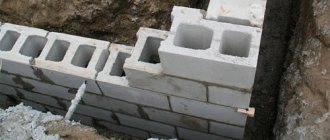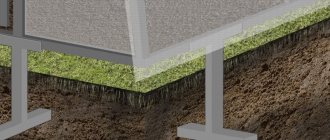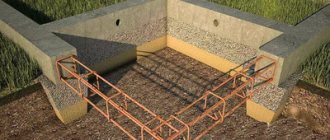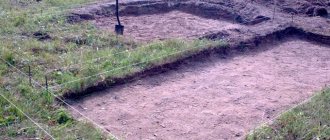Technology and stages of construction of a columnar foundation
Preparatory stage
It starts with cleaning the area. To do this, the top layer of soil is cut off along with the vegetation. The thickness of the layer is about 300 mm, and it is not suitable for a base. If there are clay soils on the site, then a gravel and sand backfill will be needed. Its thickness is determined by calculations based on geological data about the soil. After cleaning the site, it is graded. All irregularities are removed, and soil is poured into the existing holes.
Foundation breakdown
The purpose of this stage is to transfer the house plan from the drawings to the land plot, fixing the axes and main dimensions of the foundation. The accuracy of the layout must be checked by measuring the diagonals of the plan (they must be the same) and checking the corners of the foundation - they must be strictly 90 degrees.
Digging holes
Pits for reinforced concrete foundations are dug using an excavator or manually. All of them are located exclusively along the axes. If the depth does not exceed 1 m, then you can do without wall fastenings. And at a depth of more than 1 m, they dig with slopes and arrange fastenings from boards with spacers (to prevent the soil from falling off). The pits are made at 250-300 mm. greater than the depth of the foundation (for the installation of gravel and sand backfill). In width, the pit should also be larger than the future foundation. This is necessary to ensure that the formwork and spacers can be installed.
Installation of formwork
For formwork, planed boards with a thickness of 25 - 40 mm are used. and having a width of 120-150 mm. The planed side is installed against the concrete. Also, chipboard, moisture-resistant plywood, and metal sheets can be used as formwork material. Iron, ceramic or asbestos-cement pipes with a diameter of 100 mm or more can be used as formwork. Concrete is poured into the installed pipes, and they remain with the foundations in the ground.
Foundation reinforcement
Reinforcement of pillars is carried out in the longitudinal direction with reinforcing bars of grade A3 and a diameter of 10 -14 mm. with the installation of horizontal jumpers with a pitch of at least 200 mm. Wire with a diameter of 6 mm is used as jumpers. For the future connection of the reinforcement frame of the pillar and the monolithic grillage, it is necessary to ensure that the rods extend above the edge of the foundation (as can be seen from the photo) by 10-20 cm.
Pouring concrete
Concrete is laid in layers, 200-300 mm each. using deep hand vibrators. This ensures the homogeneity of the mixture and removes air from the solution.
Waterproofing a columnar foundation
Waterproofing is carried out using the same materials as for a strip foundation: various rolled lining membranes, hot and cold mastics, or the “old-fashioned” method - two layers of roofing felt on bitumen.
Grillage installation
The monolithic belt (grillage) provides the necessary longitudinal rigidity and stability of the entire foundation structure. It can be made using prefabricated reinforced concrete rand beams or monolithic. Before installing the prefabricated belt, the jumpers are securely connected to each other using scraps of reinforcement, welding them to the mounting loops using welding. After this, the formwork and reinforcement frame are installed and poured with M200 concrete.
After the concrete has reached the standard strength and carried out waterproofing measures, you can fill the holes in the holes with soil and proceed to the installation of floor slabs.
Cladding of a columnar foundation
Nowadays, columnar type foundations are very common, when the base of the house is not made solid, but in the form of rows of supports. Such foundations include screw columnar foundations, SIP foundations, classic columnar foundations, foundations made from standard concrete piles and many others. It is better to close the gaps between the piles with something.
Closed pile base
The best choice for sewing up the base would be a monolithic wall made of concrete or stone. It will rest on stilts and ensure their stable position in space, and can reliably close the basement from dust, dirt and rodents. This is very important for houses made of stone materials and aerated concrete. The piles may move relative to each other due to soil movements, and cracks will appear in the walls of the house. To prevent this from happening, after installing the piles, a monolithic plinth wall made of concrete is erected, which ties the piles together and ensures the rigidity of the structure. It is built before the walls of the house are erected.
Before erecting a monolithic concrete base on heaving soils (clay and loam), preparatory work is carried out. First, the soil is torn off to a depth of half a meter and a width of half a meter in each direction from the piles along the entire perimeter of the foundation. Then geotextiles are laid in this pit, extending half a meter in each direction beyond the edges of the pit.
1x1 meter sheets of geotextile are preliminarily laid under the piles, cutting a hole in each for it. The protruding edges of the geotextile then need to be covered with a blind area and basement screed.
After this, a sand-gravel mixture is poured into the resulting pit and compacted. A layer of waterproofing is made on top, formwork is installed, reinforcement is mounted and the base is poured. When building a blind area, you need to lay drainage on top of the geotextile. Next, the base can be sewn up using any of the methods described below, or simply painted.
What is required: tools and materials
Fixing the fences can be done using two methods:
- With support on the ground.
- Based on the building.
Depending on the chosen design option for the fence, the type of its fastening is selected and the appropriate materials are prepared.
Trenches resting on the ground require excavation work - a trench up to 50 centimeters deep is prepared for them, a sand cushion is created at the bottom, after which the trench is filled with a concrete mixture.
The simplest option is considered to be a suspended pick-up. It requires a frame, which is created from a metal profile or wooden beam.
How to close a columnar foundation?
Taking into account the properties of the soil on which the foundation is located, you can choose two types of fastening the fences: those that are attached to the building and those that will rest on the ground.
There are several interesting solutions for covering a columnar foundation. The cost of the material and the complexity of the work will determine how protected your home is from water and cold, as well as its decorative appearance.
Hanging pick-ups
They are cheaper and easier to implement. For this method, you can make a frame from a wooden beam or use a metal profile. It is recommended to treat the frame with a special substance that resists flame and protects against fungi and other harmful organisms.
Base insulation
If you have to attach the insulation to the piles, without a monolithic base, first sew up the base. It is most convenient to use glass-magnesium sheets - they can withstand being in water, are frost-resistant and quite durable. They are attached to the piles, then covered with a vapor barrier and foam is attached. After this, the siding bars are installed, pulled through with self-tapping screws through the foam to the piles, and the siding is installed.
For a monolithic base and foundation, you can simply attach polystyrene foam from the outside, covering it with waterproofing below the ground level. Through it, siding guides are attached to the concrete.
The main factor when carrying out work is the possibility of maximum insulation of the foundation.
Work process:
- Insulation material should be placed in a pre-dug trench. The most popular is polystyrene foam.
- The insulation is fixed in the trench using glue. No gaps or cracks should be allowed.
- Then the trench must be covered with a layer of sand. It must be compacted well and filled with water. Instead of sand, you can use small crushed stone or gravel.
- Performing a bridge.
- Finishing of external sides with decorative materials. Their choice depends on the preferences of the owner and the design of the building.
We invite you to familiarize yourself with Vanilla Orchid (Vanilla Orchid) care at home: 7 most important rules, propagation, photos of varieties
If the base of the building is high enough (more than 65-70 cm), then the following actions must be taken:
- To increase strength, it is necessary to make a metal frame and install it between the floor beams
- Shields made of metal profile material should be secured to the outside of the frame.
- Plates of insulation material are attached to the inside of the metal structure using special glue. There should be no gaps or empty spaces between them.
- After completion of the work, both the internal and external sides must be treated with the material - expanded clay.
- Every 1.5-2 meters it is necessary to install ventilation holes with a diameter of 14-20 cm. They should be located on opposite sides strictly opposite each other.
A false base made of any material protects against the penetration of precipitation, debris and animals, but not from the cold. To protect the basement from frost, a thermal insulation layer is needed.
It is convenient to mount sheets of polystyrene foam or expanded polystyrene under the base. A film or roofing material is placed between the insulation and the external finishing to prevent the formation of condensation. It is also convenient to install expanded polystyrene boards on the inside of the masonry.
Regardless of the foundation material, ventilation holes are left on each wall. The number and area of the holes are calculated by measuring the total area of the base and dividing it by 400.
Vents are covered with bars to protect against the entry of rodents and other small animals. It is impossible to close the ventilation for the winter, so it is done at a height of at least 25-30 cm above the blind area, otherwise they will be constantly covered with snow.
Arrangement of the basement with a columnar foundation
Experts recommend installing a basement with a columnar foundation immediately after finishing work on pouring the foundation of the house.
It is important to carry out this stage before the installation of wall structures begins, since their role in this process will be expressed in the natural weighting and compaction of the resulting base. As a rule, it is formed by tying the pillars, which is called grillage tape. To do this you need:
- install formwork between the foundation pillars with a slight depth of 20 cm;
- pour a gravel cushion in a layer of 15 cm;
- compact the gravel by wetting it with a small amount of water;
- install reinforcement in the form of metal rods;
- arrange pipes from scraps of asbestos pipe on each wall of the base, ensuring that the ventilation holes are not opposite each other (this can cause drafts;
- fill with concrete mixture grade M 400.
A layer of waterproofing material is laid on top of the hardened concrete mixture. This can be roofing felt, the butt joints of which are fused using a roofing torch, blowtorch or welding machine. An economical option for arranging the base of a columnar foundation is the following technology:
- permanent formwork with a slight depth is installed;
- a sand cushion is poured;
- the space between the outer and inner walls of the formwork is filled with clay, which is then moistened and thoroughly compacted.
Subsequent finishing of such a plinth can only be carried out using hanging facade technologies.
The outer side of the formwork after laying the waterproofing layer can be covered with plastic panels imitating masonry, siding or sheets of profiled iron. You can use an economical option when building a country house.
TOP 3 best ways to cover a pile foundation from the outside
The most popular building materials for finishing a pile foundation:
Basement siding
note
When choosing any option for finishing the foundation, you must leave at least 2 dormer holes for ventilation. They should be located on opposite sides.
What is the main function of the foundation plinth?
The base is that part of the building’s foundation that performs one of the most important functions – protective. The protective function of finishing the foundation from the outside is:
- An obstacle to drafts, snow and rain. Thanks to this, heat loss is minimized.
- A method in which large differences in temperature and humidity do not occur, which helps create a normal microclimate under the building, and this in turn has a positive effect on the condition of the screw foundation.
In addition, the closed foundation of the building does not allow various living creatures to set up their homes under the building.
Edged board is an excellent construction and finishing material; it can also be used to cover the outside of a pile foundation.
- The main advantage is environmental friendliness and safety.
- The material does not release toxins into the air either under the influence of moisture or temperature changes.
- The edged board is durable and reliable, it has low thermal conductivity.
- In addition, wooden boards are antistatic and anti-allergenic.
Flaws
But, like any material, edged boards also have their disadvantages, these are:
- Low level of fire safety.
- Low resistance to rotting, deformation, mold and mildew.
- It does not tolerate high humidity.
- Low sound insulation qualities.
note
In order to ensure a long service life for the material, it must be periodically coated with various protective compounds.
The approximate cost of a 25x100 mm edged board is 7,000-11,000 rubles per cubic meter.
Brick is an artificial stone of a rectangular shape, the dimensions of which are 250x120x65 cm. It is used as a construction and finishing material.
It is made from mineral materials, so it has the properties of natural stone.
- Strength.
- High density.
- Environmentally friendly.
- Frost resistance.
- Water resistance.
- Excellent sound insulation.
- Long service life.
Flaws
The disadvantages of this material include:
- High cost (about 10-13 rubles per piece).
- The formation of a white coating (efflorescence), which spoils the entire appearance of the brickwork.
You can begin work on arranging the basement at any time. It is even desirable when the construction of the house has already been completed and all utilities have been connected to it.
Most private houses built during the Soviet period are built on columnar foundations. A columnar foundation is used as a foundation for buildings with relatively light weight and giving minimal load. Among such buildings one can note ordinary wooden buildings, baths, sheds, barracks, etc. A columnar base is the most popular option for construction. This is due to its cost-effectiveness and ease of implementation. However, many owners, after several years of operation of such structures, are increasingly beginning to wonder: how to cover the columnar foundation from the outside? The fact is that the design of the base allows cold air currents to pass into the building.
Covering a columnar foundation with siding
Scheme of covering the foundation of a house with basement siding.
In most cases, in order to cover the columnar foundation from the outside, materials containing polyvinyl chloride are used. This is due to the fact that these products boast a high level of strength and massiveness, unlike vinyl-based products. The thickness of polyvinyl chloride exceeds 0.3 cm.
Currently, siding is made only from modern high-quality materials, so it can boast of its long service life. Moreover, the material perfectly withstands environmental influences. The siding contains specialized modifiers that prevent the material from fading even when exposed to direct sunlight.
Currently, a huge range of these products is available in stores and construction markets. It imitates natural materials to the highest degree, both in color and texture.
You can find siding that at first glance looks like brick or natural stone. Of course, this material will cost several times less at its price. In addition to all of the above, siding is quite simple to install, therefore, the work time will be significantly reduced.
Siding for the base is fixed to a wooden sheathing.
The most important thing is to remember that before strengthening, the sheathing must be coated with compounds that resist flames and destructive organisms.
In addition, this material is not afraid of mechanical damage and natural factors. It is for these reasons that its service life reaches up to 50 years.
Advantages and disadvantages of NSF
Like any building structure, non-buried point supports have their own advantages and disadvantages.
The reasons why developers choose a shallow columnar foundation are explained by the following advantages over other types of foundations for buildings and structures:
- the simplicity of the design allows land owners to build supports with their own hands, without involving professional builders and special equipment;
- columnar supports can be installed on almost any soil, except for soils with active heaving processes and in places with a high groundwater level (swampy grounds);
- non-buried pillars are erected in areas with differences in elevation, for example on hillsides;
- there is no need to arrange complex and expensive waterproofing of foundation structures;
- the maximum period for erecting supports does not exceed 2 weeks;
- there is no need to carry out excavation work to level the landscape;
- made in compliance with the rules and regulations of construction, the foundation of the building can last 50 years or more;
- The main argument in favor of shallow columnar foundations is the low cost of materials and work.
Compared to the impressive list of advantages, only 2 disadvantages can be noted - these are:
- impossibility of constructing basements and basements;
- intended only for light buildings and structures.
Insulation of false base and material compatibility
The issue of insulation of a false base needs to be resolved based on climatic conditions
If the house will be used only in the summer or the climate is mild, then an insulated floor is sufficient.
For false plinths, it is recommended to use external insulation, which retains heat and shifts the dew point towards a material that is more ready for temperature fluctuations and the appearance of condensation.
Insulation materials are suitable for various insulation options, but they must be used differently depending on it:
- Frame false plinths are insulated on top, after which they can be decorated with a finishing coating, for example, siding.
- The brick lining is first sealed, if there are cracks, covered with a primer, and then the insulation is glued or otherwise installed. Next, you will need to stretch the polymer mesh and plaster the surface. The final finishing is carried out with tiles or the surface is painted.
Foundation installation
The installation technology will vary depending on the type of foundation. But the general diagram of how to properly make a columnar foundation looks like this:
- Preparatory work, drawing construction.
- Carrying out earthworks: marking, digging holes and trenches.
- Filling cavities or laying blocks.
- Removing formwork and adding sand. Insulation of the base, waterproofing and installation of the fence.
This is the most general scheme, which varies depending on the type and depth of the foundation. However, the first stages of work are the same for everyone.
Preparatory work
Before starting construction of the foundation, it is necessary to draw up drawings.
Example of a foundation drawingSource 2mdom.ru
The drawings indicate the layout of the pillars. They are usually installed in places of heavy loads: in the corners of the building, at the intersection of load-bearing walls, under load-bearing partitions.
In addition to the drawing, it is useful to have a diagram of the foundation itself.
Example of a foundation diagramSource prezentacii.org
When you have all the necessary materials and drawings on hand, you can begin preparing the area for the future building. First of all, the area is cleared of debris. Then two meters are counted from the perimeter of the future building and this area is marked with a cord or sand. This is the boundary from which the top layer of soil must be removed to prevent plants from sprouting. You need to remove approximately 30 cm of soil. A layer of sand or gravel is poured into the dug pit.
Then they move on to the marking stage. The drawing is transferred to a plot of land. The corners of the building are marked with posts with wooden strips nailed to them.
The correctness of the angles must be checked by measuring the diagonals. A rope is attached to the planks, which outlines the boundaries of the building and the location of the supports.
Foundation markingSource sazhaemvsadu.ru
Pit preparation
Holes are dug in the places marked for the posts. You can do this yourself, using an excavator or mechanical drill. The width and depth are dug with reserve for formwork and bedding.
Foundation pitsSource banyagid.com
If the holes are deeper than 1 m, then they may begin to crumble. To prevent this from happening, it should be dug with slopes and spacers made of boards should be installed. After this, you can lay the pillow.
Installation of foundation pillars
Once the holes are dug, you can begin to install the posts. First, a drainage pad is laid. It consists of a layer of sand (10-20 cm) and crushed stone (5 cm).
Pillow for the foundationSource 1landscapedesign.ru
To avoid sagging, the pillow must be compacted well.
Further installation technology depends on the type of foundation.
How to cover a columnar foundation
Question:
Hello, dear Semenych! We have floating soil, we removed the old rickety blocks under the panel house, put reinforced tiles on the sand cushion, and placed blocks and pads on it.
Question: is it necessary to cover the empty space with something between the external supports so that rain and snow do not get under the house? And how best to do this if the blocks extend outside the vertical wall? Thank you very much for your help. God bless you!
Natalya, Moscow.
Answer:
Hello, Natalya from Moscow!
To cover or not to cover the empty space between the support blocks under the garden house?
Each house owner decides this in his own way.
There are buildings that stand in this condition for many years and there is nothing wrong with that.
Other owners believe that the aesthetic appearance of a house “on stilts” is too scary a sight and try to cover up such disgrace.
What are the consequences of the lack of closures between blocks? Well, firstly, what you said, that is, rainwater and snow will get under the house, not counting all kinds of garbage and stray dogs that like to hide in such places.
In addition, the space under the house will be constantly ventilated. Ventilation is good for removing excess moisture under the floor, but such drafts cool down the floor, even if it is insulated in some way.
Of course, no one keeps statistics on how many buildings have such closed gaps, but still most people prefer to close them.
This is done using various materials. Someone is actually digging a trench. fills it with reinforced concrete, and makes brickwork on top, bringing it to the lower base of the house frame.
But most often this problem is solved by installing a frame made of a cranial wooden block with a cross section of 50/50 millimeters, which is attached partly to the outer surface of the walls of the house along its bottom, and partly to the support blocks themselves.
Then, either sheets of flat slate (as an option - DSP, that is, cement-bonded particle boards) or basement siding are hung and attached to this frame. The latter is a rectangular plate, if memory serves, about a meter long and about 0.6 meters high. With imitation of natural stone, brick, etc.
Since the distances from the bottom of the house to the surface of the ground vary, the lower part of the cover often has to be trimmed with a grinder.
And to make it all look even better, they often also make a blind area around the house. Some expenses lead to other expenses. Beauty requires sacrifices, including financial ones.
Sometimes, instead of wooden bars, a metal profile is used to install the frame. The same thing that goes under drywall or all kinds of wall tiles.
The fact that the surface of your support posts protrudes somewhat beyond the dimensions of the walls does not particularly affect the installation of closures. Simply, galvanized or painted iron ebbs are installed along the top of the ledges and along the entire perimeter of the house. With a shelf width sufficient to cover the projections. In the image and likeness, as is done on the outside of window openings along their lower part.
In my answers to questions I have already depicted sketches of similar ebbs, but so be it for you, I will do it again, albeit without detailed descriptions. I’m busy trying to answer other questions; I don’t have any time.
Sketch of the basement closure of the bottom of the house
Good luck!
Construction in Moscow and Moscow region
We work with a guarantee! Wide range of construction services.
Foundation, walls, ceilings, roofing, turnkey! +7 (916) 318-60-60
domstroykolomna.ru
Other questions on the topic of walls in various rooms:
- Zavalinka
- Base
- Cover the house with bricks
- Everything is on the walls
Zavalinka
- The blockage of a house on the blind area
- Repairing the rubble of an old house
- Repair of the blockage
- Filling and insulation of the lower crowns of the log house
- Low base made of FBS
- Should the inside of a log house be lined with clapboards?
- Restore a brick wall with mortar
- Selecting columns to support the second floor wall
- How to place a heap correctly
- Make a pile to protect an old house
- Do-it-yourself filling
- Heap for an extension without a foundation
- Heaping on a pile foundation and ventilation
Base
- Lining crowns made of logs with natural stone
- FBS plinth on a monolithic slab
- Mortar is pouring out between the bricks of the basement
- Lay the base with foam blocks price
- How to make windows in a brick basement
- Wooden plinth finishing
- Economical repair of a crumbling base
- The basement under the utility room gets wet
- Leveling the foundation with a brick plinth
- Socle made of sand-lime brick and its finishing
- What is between the foundation and masonry
- How to cover a columnar foundation
- DSP base
- Finishing the base with stone panels
- Waterproofing the walls of a brick house
- Raise the plinth on the slab foundation
- Set up a garage basement on heaving soil
- High brick plinth
- Finishing the base and blind area of a columnar foundation
- Restoration of the foundation plinth
- Brick plinth on a concrete foundation
- Is it necessary to raise a concrete plinth with bricks?
- Make a brick plinth on a strip foundation
- How to preserve basement floor joists
- Noisy plastic canopies on pits
Cover the house with bricks
- Cladding a house with blocks - how to fill the gap
- How to cover an adobe house with bricks
- Finishing the façade from expanded clay concrete blocks
- Documents for house reconstruction
- Steps made of brick and decorative tiles
- Cover the house with expanded clay concrete blocks
- How to cover a brick house with facing bricks
- Foundation for brick cladding
- Foundation for brick lining and insulation
- How to brick an adobe building
- How to veneer block walls with bricks
- How to decorate a house with small windows
- How to decorate a house beautifully
- Repair of the wall of an embankment house lined with bricks
- Cover a house made of sleepers without a foundation with bricks
- How to close vents when laying bricks
- Construction and strengthening of a half-brick pediment
- Crack in the brick lining of a house
- Cover the panel room with bricks or blocks
- How to cover an old house?
- Buying an oak house lined with brick
- The wall burst while covering the house with bricks
- Insulation of a log house when facing with bricks
- How to cover a wooden house with bricks
- How to cover a log house on screw piles with bricks
- How to cover an adobe house with bricks
- How to cover an old wooden house to make it stand
- Cover a gas silicate house with bricks
- How to cover a house with blocks
- How to cover wooden walls with bricks on both sides
- How to brick a house
- The beam crushed the facade of a brick-lined house
- Velo house lined with bricks
Construction in Moscow and Moscow region
We work with a guarantee! Wide range of construction services.
Foundation, walls, ceilings, roofing, turnkey! +7 (916) 318-60-60
domstroykolomna.ru
Questions about the walls
- Breathable Pie Frame Wall
- How to determine the material of the walls of a house
- Drywall adhesive for clay plaster
- Insulating the walls of a frame bath
- Wall decoration from sleepers
- Restoration of foam concrete walls after a fire
- Insulation of brick walls from the inside
- Restoration of varnished lining
- Treatment of external walls made of aerated concrete
- Part of the wall of a frame house sank
- Frame partition in a house made of timber
- Led walls made of timber
- Log partitions in a panel house
- Cladding a fentilated timber house façade
- Wall made of foam block in two rows with insulation
- Replacing bathhouse walls without dismantling the roof
- How to update the external walls of a brick house
- Cracks in the walls of a cinder concrete house
- Cladding of timber walls with clapboard from the inside
- The house is 50 years old - reconstruct or demolish
- Cracked corner of a house made of aerated concrete blocks
- Cracks in the corners of an old combined house
- Partition wall reinforcement
- Strengthening a doorway in a cinder wall
- The slate wall bulged
- Monolithic house on different levels
- Quality of wall panels
- Building a new house around an old one
- Replacing a section of a wall made of timber with aerated concrete
- Blind area and crack on the wall of a brick house
- Armobelt for a house made of wood concrete
- Lining a timber house from the inside with clapboard
- Strengthening a prefabricated panel house
- Finishing a bathroom (floors, walls, ceiling) in a wooden house
- Reworking the project of a house made of aerated concrete into timber
- Leveling a panel house on heaving soils
- Facade plaster is peeling off
- The brick vestibule extends away from the house
- The corner of a panel wooden house diverges
- Build a house around an old cinder block
- Repair of a pre-revolutionary brick house
- Summer kitchen and bathhouse made of 125 mm thick gas block
- Finishing the façade from expanded clay concrete blocks
- Interior partition made of timber
- Repairing a burnt wall
- Reconstruction of an old brick house
- The walls of a slag-cast house are cracking
- Finishing the log floor on both sides
- Protecting facing bricks from sparrows
- How to soundproof the fifth wall (log) in a house
- Major repairs of a slag house
- Internal lining with clapboard or imitation timber
- Wooden pallet house
- The geometry of the house is broken
- Expanded clay concrete blocks in the open air
- The plastic covering near the electric stove is burning
- The wall gets wet from the corner
- House made of foam block with ceilings made of sip panels
- Insulating a wall from PVC panels from a gas stove
- How to move the fifth wall in the house
- Repair of timber walls
- Renovation of an old tourist house
- Tiles with a pattern near the gas stove
- Aligning the walls of the house vertically
- How to tie a log wall to a cinder block wall
- How to clad a garden house
- How to determine the material of the walls of a house
- Finishing a foam block wall with plasterboard
- Joining a log house and a wall made of aerated blocks
- How to connect the walls of a house and an extension
- Attaching nets to wooden frames
- Painting MDF panels
- Reconstruction of the walls of an old house
- Strengthening the old panel house
- Tiles on a timber wall
- Renovation of an old stone house
- Expanded clay blocks or gas blocks
- What to build a house from
- Cut an arch in the wall of a frame house
- Waterproofing walls from the ground in an adobe house
- Clay hut on the facade of a timber house
- Damp walls in a twin block house
- Joining sand block and cinder block walls
- Finishing a log house, a year after installation
- Inserting a load-bearing wall into a log house
- Construction of a building - brick or wood
- Exterior decor of a timber house
- Should I build from an old log?
- The bathhouse leaned due to a poor foundation
- Connection of block walls to the log house
- Seismic resistance of a private house
- Restoring a cinder block house after a fire
- Walls made of metal profiles for a country house
- Lining a log house from the inside
- Temporary house 6 by 6 m
- Methods for installing wooden lining
- Facing bricks are crumbling
- Load on edged board
- Questions about frame construction
- Strengthening the frame after the grief of the builders
- Repair of the lower crowns of a half-beam house
- Internal walls made of foam blocks in a SIP house
- Finishing the wall behind the gas stove
- Repair of cinder block walls of a house
- The gables are leaning, what should I do?
- Sheathing a log house with planks on the outside
- Finishing timber walls with imitation timber
- Cover the metal pillars of the canopy with ceramic tiles
- Problem with cinder block walls
- Combined house made of blocks and logs
- Red brick crumbles in the wall
- Decorating the interior walls of an old log house
- How to plaster timber from the street
- Laying tiles on DSP in the bathroom
- How to cover the walls in an old summer house
- Painting wall panels
- Support pillars for the foundation
- Interior decoration of the walls of a country house
- Protection of lining indoors
- Facade cladding with metal profiles
- House made of foam block with ceilings made of sip panels
- Should you buy a house with a crack in the wall?
- Cover a hewn log wall with plasterboard
- Foil-coated isolon for lining sheathing
- How to sheathe the inside of a frame house
- Installation and installation of an interior wall made of clay
- Armobelt for brick walls under slabs
- How to find out what a house wall is made of
- Frame house pie
- How to attach imitation timber to external walls
- How to putty polystyrene with bark beetle
- How to attach lining to corrugated sheets
- Gaps between gable boards
- Bulk walls are diverging
- Wall of a timber house
- The timber wall vibrates
- Repair of brick walls
- What material to choose for the facade of a timber house
- Finishing the timber from the inside
- Base for ceramic tiles in a timber house
- Lathing for imitation timber inside the house
- Internal insulation and cladding of a country house made of timber
- How to cover a brick plastered wall with clapboard
- Repair of plasterboard walls
- A log was pushed into the room above the doorway
- How to lay tiles on plywood
- Preservation of the construction of a block house for the winter
- Gas block or wood for building a house
- Repairing void corners of an old house
- Protecting eurolining for the winter
- Interior walls in a log house
- Fiberglass rods to strengthen masonry blocks
- Metal profile over OSB
- Converting panel walls to timber walls in a house
- Level the wall of a log house
- False walls in an adobe house
- Level the walls of a house from sleepers
- Tire Shed or Earthships Home
- Crack in a brick wall of a house
- Do-it-yourself clay pot
- How to attach timber to a concrete floor (for a wall)
- Sheathe the inside walls of a house made of sleepers with plasterboard
- House facade renovation
- Waterproofing between foundation and wall
- Plastering adobe walls
- What is the best way to cover the walls and floor of a garden house?
- Finishing interior walls with imitation timber
- Restoring old brick in arches
- Application of liquid wallpaper on adobe walls
- Strengthening an old brick garden house
- Attaching drywall to the timber wall of a house
- Cladding a timber house outside and inside
- How and with what to plaster a timber house
- Screed adobe walls
- The walls in the house are damp
- Tongue-and-groove slabs as walls in a log house
- What is the best way to cover the walls of the steam room?
- Leveling walls using old oil paint
- Finishing the external walls of an adobe house
- Repair of old walls for wallpapering
- How to line a wall in the kitchen
- Walls made of kalyb stone
- Replacing log walls with stone
- Repairing stone walls of a house
- Strengthening the foundation and walls of an old house
- Repairing the walls of an adobe house
- Reworking backfill walls
- Cladding the walls of a wooden house with plasterboard
- Remove echo and insulate gypsum plasterboard walls
- Timber floors in block walls
- Lathing for lining on log walls
- Make a window in the wall from timber
- How to make and insulate bath walls
- Wall cladding with larch boards
- Terracing and retaining walls made of natural stone
- Insulation of a brick wall
- Cracks in walls and gables
- Crack in the wall of a brick house
- Installing siding in November - snow, rain. Installation and insulation of floors and walls.
- How to tighten the wall of a wooden house?
- Decorating kitchen walls with MDF panels
- The brick of the false foundation wall is crumbling
- Walls made of kalyb stone
- Tire walls
Construction in Moscow and Moscow region
We work with a guarantee! Wide range of construction services.
Foundation, walls, ceilings, roofing, turnkey! +7 (916) 318-60-60
domstroykolomna.ru
Walls
All questions to Semenych about construction
Semenych (author of materials)
Our site is regularly updated with interesting and unique materials and articles on the topics of lumber, building materials and works, the author's opinion and knowledge of a real coven with more than 15 years of experience are provided. There is a section - funny stories of shabashniks. If you would like to receive information about this, subscribe to our website's newsletter. We guarantee that your address will not be shared with third parties.
Apartment renovation in Moscow and Moscow region
We work with a guarantee! Wide range of repair work.
Professional craftsmen. +7 (905) 797-20-34
luxurycomfort.ru
| Country house | Bath |
| For the dacha | Tool |
| Materials | Tales |
| Foundation | Log houses |
| Roofs | Insulation |
| Walls | Siding |
| Floors | Cellars |
| Attics | Doors windows |
| Stairs | Extensions |
| Wells | Toilets |
| Balconies | Loggias |
| Condensate | Flooding |
| Fences | Kennels |
| Sidewalk | Birdhouse |
| Adobe | Carts |
| Garages | Barn |
| Greenhouses | Bath |
| Swing | Brazier |
| Shower |
| Horizontal bar |
Which material to choose
Only after considering all possible options for installing a columnar foundation, and assessing all the pros and cons for each of them, will it be possible to settle on the most optimal type of basement partition. When choosing an option, it is imperative to take into account compliance with climatic and operating conditions, as well as other requirements imposed on it, such as: ease of installation, practicality and aesthetics.
Despite the fact that installing a columnar foundation from cobblestones is the most labor-intensive and expensive option, its main and significant advantages are: reliability, strength and durability. Therefore, when building a wooden house, this option for the basement structure is most often chosen.
Conclusion
Comfortable and cozy accommodation, as well as a long service life, depend on the correct and high-quality execution of work on the arrangement of the basement of the building.
Materials
Let's consider how to cover a pile foundation from the outside
It is important that the material used for finishing is durable and frost-resistant, and does not lose its qualities under the influence of temperature changes and ultraviolet radiation.
More reliable is finishing the base of a pile foundation with stone, brick, cinder block, or concrete. This will require excavation work similar to the construction of a shallow foundation.
The suspended structure is lightweight and does not require excavation work. Polymer, wood and composite materials are used, which are quickly and easily installed.
Basement siding
Basement siding is most often used for finishing screw foundations.
It is produced in the form of decorative panels with a thickness of 1 to 2.5 mm.
- Possibility of use in any climate zone, including the north;
- resistance to mechanical stress;
- light weight, ease of installation;
- has low thermal conductivity, retains heat;
- durability 40-50 years;
- does not collapse under the influence of moisture or ultraviolet radiation.
It is possible to cover the foundation of a house with semicircular shapes. For this purpose, a technology was launched into production, thanks to which the material bends easily. Panels of small thickness (1.1 mm) with the addition of synthetic threads are produced.
Profile flooring
Sometimes the question arises of how to cover screw piles so that work can be completed during the day.
In 4-7 hours you can cover the pile foundation with profile sheets.
The width is available from 1 to 4 m, due to this one sheet can cover a significant space.
- sheets with a polymer coating have a service life of 30-50 years, galvanized sheets last 10-15 years;
- Available in various shades and sizes;
- a light weight.
Disadvantages include:
- in places where the coating is damaged, the sheet is susceptible to corrosion;
- The zinc coating gradually evaporates.
Flat slate
Every year this material is losing its popularity; it is being replaced by modern, environmentally friendly materials.
- resistant to atmospheric influences;
- durable.
- asbestos is dangerous to human health and pollutes the environment;
- fragile;
- unattractive appearance.
Frame system
Is a budget option. To install the sheathing, we use vertical posts made of timber (metal) with horizontal slats and metal profiles attached between them. We attach acrylic and vinyl siding to a pre-fabricated frame. For more information on how to close the basement space in a house on screw piles, watch this video:
Leaf system
It is economically beneficial to use a sheet system.
- We fix a metal profile (corner, pipe) or wooden beam vertically;
- we fasten cement-bonded or asbestos-cement slabs;
- We lay tiles, porcelain tiles, and bituminous shingles on the slab.
Composite materials
As a composite material we use:
- lightweight polymer-sand panels reinforced with cellulose threads;
- fiber cement sheets have great strength and reliability;
Facing brick
Brickwork is a reliable, but expensive and labor-intensive method of finishing a foundation on screw piles. To lay the cladding correctly and evenly, you need to have construction skills.
- durability, strength, reliability;
- high thermal insulation qualities;
- additional support for house construction;
- aesthetic appearance.
How to cover a basement space with a brick:
- remove the fertile layer by 30-40 cm;
- we fill in a cushion of sand, crushed stone, and tamp it;
- insulate the sole;
- we lay a brick.
The masonry must be connected using metal pins to the piles. The metal is welded to the sheathing and bonded to the brick using cement mortar.
False base options
Facades lose their aesthetics without decorating the lower underground space. To veneer the foundation base with a minimum budget, you need to take into account the following factors:
- size of structural and facing materials;
- the height of the hanging grillage from the blind area;
- the thickness of the materials with which the blind area will be lined.
For example, with a standard slope of the blind area of 4 degrees, facing this strip along the perimeter of the building with paving stones, the zero level mark will rise by 8 - 14 cm. With a grillage height of 60 cm from the paving slabs, you can close the columnar foundation from the outside in different ways:
- brick - 7 rows with normal seam thickness;
- asbestos-cement sheet - there is no cutting waste, additional cladding with porcelain stoneware or tiles, the size of which can be selected for any height of installation, will be required;
- basement siding - most manufacturers produce panels with a height of 40 - 47 cm, which will lead to large cutting waste.
For masonry, you will need an underlying layer of inert material so that the half-brick strip does not swell in winter.
Sheet materials
To cover the base of the foundation with an asbestos-cement slab (flat slate), it is necessary to replace the fertile layer where the sheet material rests with sand, compacted or spilled with water in layers. The grillage is usually wider than the pillars underneath it, therefore, to cover the outside of a columnar foundation in one plane, several technologies are used:
- sheathing made of galvanized profile - the upper part of the horizontal post is adjacent to the grillage, attached to it with a dowel, the lower part is fixed at the vertical level by a suspension from the gypsum plasterboard systems to the post;
- wooden frame - usually a 10 x 5 cm block is used, the upper edge of which is attached to the lower crown of the frame, tying the frame building with an anchor in a secret hole, in the middle part to the grillage with an anchor-type bolt.
In the first case, the structure is more rigid; wooden racks are usually used with a small (40 - 60 cm) grillage height. The frame elements must be separated from the concrete structures with spacers (pieces of roofing felt), and a minimum gap of 10–15 cm must be provided between them and a sand cushion.
Wood-containing boards and plywood do not have sufficient aesthetics and need protection from moisture. DSP and ADC boards have high adhesion to tile adhesive, which allows them to be decorated with torn stone or tiles. It is impossible to qualitatively isolate the junction of these planes with sheet materials adjacent to the blind area in the lower part. If water cannot rise along the inclined surface, then when the snow that has accumulated on the blind area in the off-season melts, moisture freely penetrates into the underground through this gap.
Therefore, to seal the interface of facing materials, the assembly is waterproofed with rolled TechnoNIKOL, Bikrost, and hydroglass insulation from other manufacturers:
- the sheet is launched under the facing of the intake;
- fixed to the frame mechanically;
- the second edge is laid under the paving slabs.
Scheme of waterproofing of a pile foundation
A waterproofing carpet bent at right angles reliably protects the underground from moisture penetration.
Basement siding
Covering a columnar foundation with vinyl siding.
Most manufacturers produce vinyl siding that imitates brick or stonework. Therefore, the design of the false plinth of the columnar foundation can be easily integrated into any facades, giving the exteriors a complete look. The installation technology looks like:
- sheathing - a wooden block or metal profile mounted on the foundation, grillage with hangers;
- corners - external, internal, fastened in a vertical manner;
- panels - inserted into corner elements, fixed with locks to each other, nails, screws, staples to the sheathing.
The main advantage of basement siding is the most complete set of this facing material with additional elements. Manufacturers produce starting and finishing strips, flashings, slopes, internal/external corners to close the base without gaps.
Unlike budget vinyl, metal and fiber cement siding of this type have a longer service life, but are more expensive. They also have all the specified additional elements, but steel is more difficult to cut when fitting.
Columnar foundation
To solve this question, first of all, it is worth studying the design of the columnar base and its characteristics.
Its main part is specialized supports located in a special order under the building.
The supports must be combined into a single whole. This can be done using reinforcing mesh, grillage or special beams.
When a columnar foundation is needed:
- When constructing low wooden structures
- When constructing buildings with missing basement structures
- If there are difficult conditions on the land plot
When choosing this type of foundation, it is worth dwelling on its main advantages:
- Ease of manufacture
- Available building materials
- Possibility of step-by-step work that does not require simultaneous expenditure of all available resources
- Ability to carry out construction work independently
However, we should not forget about the obvious negative aspects of the base:
- Construction is possible only for light buildings
- Impossibility of building a basement
- To prevent damage, a rigid grillage should be installed
- Not suitable for tall buildings
Device
What does the structure consist of? The construction of a columnar foundation includes the following important elements:
- Pillars. They are made of pipes, wood, brick, reinforced concrete. It is recommended to use asbestos pipes or reinforced concrete, since these materials are more resistant to external influences and have high strength indicators.
- Formwork. It is made of boards that are planed on one side (attached to the concrete part). Wood of any species is used for formwork. Their thickness is 25–40 mm, and their width reaches 120–150 mm. If you use large boards, gaps may form during installation. It is not recommended to use metal to create formwork, since this metal is heavy and adheres more strongly to concrete.
- Fittings. To reinforce the pillars, rods with a diameter of 10–12 mm are used. After every 25 cm, clamps are attached to prevent the reinforcement from moving to the side. The rods are placed vertically and brought out on top of the foundation to weld the reinforcement of a solid grillage.
- Grillage (prefabricated reinforced concrete or monolithic). A monolithic grillage is able to provide the required rigidity, as well as high reliability of the structure. Prefabricated jumpers are connected to each other by tying mounting loops of twisted wire. You can also use welding with cutting reinforcement. Formwork is installed on the lintels, as well as a reinforcement cage, after which the concrete mixture is poured.
- Pickup. In order to insulate the space created during construction under the floors and protect it from the accumulation of debris, a fence is provided. With its help, the wall running between the pillars is fenced. The fence is made from different materials, but brick or stone is often used for such purposes. The creation of this structure involves the presence of a concrete screed, which acts as a base. It is not buried and is laid on a bed of sand. To create a concrete screed, you need a reinforcement cage, as well as formwork. The pick-up is placed on the screed, holes are made in it to provide the possibility of supplying communications.
- Waterproofing system. To protect the structure from moisture, the upper part of the pillars and fences is covered with bitumen. Then roofing material is wrapped.


